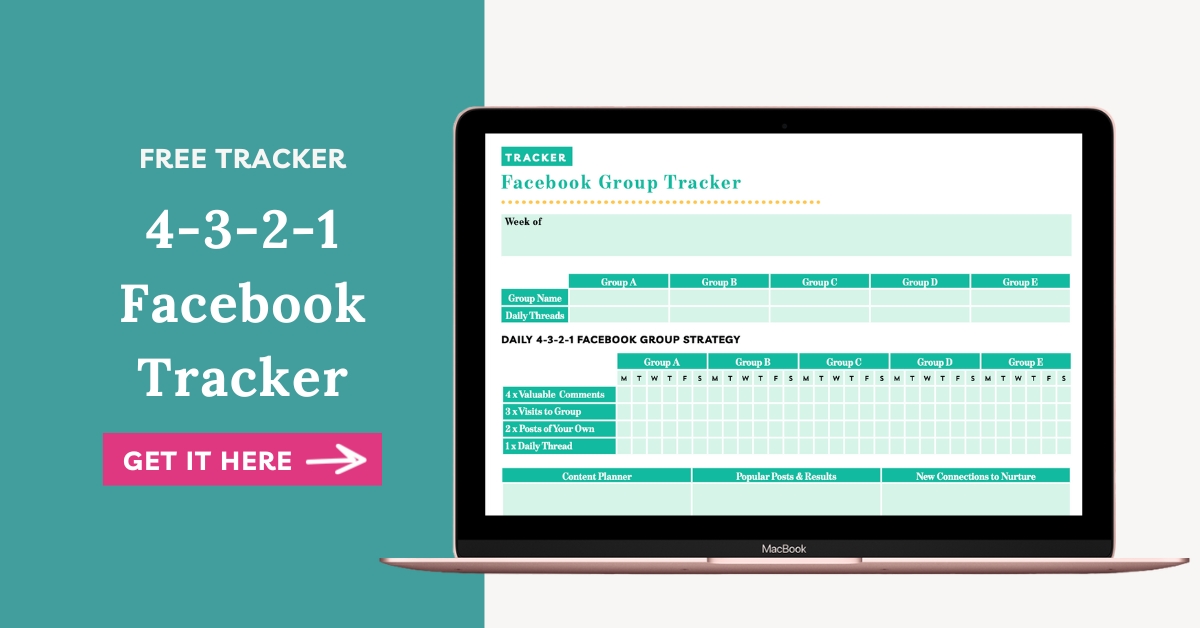I’ve met at least half of my clients in Facebook groups so I know how powerful they can be – especially when you’re just starting out. I can’t think of a better place to meet and interact with new people + and give free help and support in your zone of genius.
Here are some steps you can take to get on your Facebook Group A-Game! Let’s Get Started – Finding New Clients in Facebook Groups.
Step 1 – Make sure your Facebook profile is set up to generate leads
Before you begin the client-generating work in Facebook groups, it’s important to make sure that you have your ‘tools’ set up (in this case your profile and business Facebook page).
Think about it: If you’re engaging in a conversation in a group and someone says something so brilliant and insightful that you HAVE to know more about this person and what they do. When you hover over their name and click on their profile, their business information is nowhere to be found. Oh well, I guess you’ll find someone else.
Or maybe the information is there but when you click on their business name, it brings you to a business page that hasn’t been updated in 6 months and looks a little like a digital ghost town. That great first impression might not count for a heck of a lot anymore.
So here are the steps you’re going to take to make sure this doesn’t happen to you #NotOnMyWatch
- Pick the best pic you have of yourself and change your profile image
- Change your place of work to be your business and make sure it links to your Facebook business page (unfortunately, you can’t link directly to your website) and make sure that it’s publicly viewable
- Go to your business page and make sure your website is working, you’ve filled out your business page profile
- Start posting (even just once a week with your new blog post is better than nothing!)

Step 2 – Finding Relevant (to your ideal customer) Facebook Groups
Next up is finding Facebook groups that are loaded with your potential customers so you can build your reputation as an expert and as someone who provides a lot of value with them.
The goal of this is to find a manageable number of groups to actively participate and be seen in almost every single day. The number of these groups varies from person to person (depending on what other channels you’re using or how much time you have available) but from asking around I’ve found it ranges from 3-10.
Qualities of a Good Prospect-Rich Facebook Group for You:
- Full of potential customers who need your services
- Active – with lots of people posting relevant questions on a daily basis
- Admin of the group is a direct competitor
- Group rules allow you to post and provide value (even if they don’t allow you to directly pitch or promote with links)
- Passes the introduction test – when you introduce yourself + what you do, you get engagement on your post (requirements: a properly crafted-to-engage intro post)
Properly Crafted-to-Engage Introduction Post
- Branded picture of you!
- Opens with who you are, what you do and a fun fact about you
- Then where you can be found (website or landing page)
- Ends with a call-to-action and sign off (so happy to be here + if you need any help with x, do y)
Steps to finding your Facebook Groups
- Decide on the number of groups you want to actively participate in
- Evaluate the groups you’re already in to see if they fit the bill
- Do a group search
- Type: “People who are interested in [your topic]” and click on groups on the top options
- Type “People who like [competitor’s name or related business]” and click on groups on the top options
- Look at your suggested groups
- From home screen on Facebook, click on ‘Groups’ in left-hand sidebar
- From top-bar options, click on Suggested Groups
- When you’ve found a great group, look at the ‘suggested groups’ on the right-hand side of the group page
- Once you’ve settled on your groups, commit to participating in them for the next 30 days before evaluating and moving on
Step 3 – Create Your Posting Strategy
The most important word for the next step is consistency. Consistently showing up, consistently providing value and consistently engaging in real conversations.
Here is the 4-3-2-1 to-do list for each of the groups you’ve chosen:
4 – People helped on their own posts in each group
3 – Visits in the group per day
2 – Your own posts in each group
1 – Contributions in the group’s daily thread
Download the Facebook group worksheet to create your own Facebook group strategy.
Step 4 – Building Relationships
Reach out to people and take the relationship off-Facebook. This doesn’t mean you should be a creep and spam everyone who throws you a like on your post, but if you find you’re engaging with the same person (or few people) again and again: Friend them and throw them a message.
Take Action Now to Grow Your Business with Facebook Groups
Need some extra support with this process? Click on the image below to get the Facebook Group Tracker and to be notified when the next steps are released.








